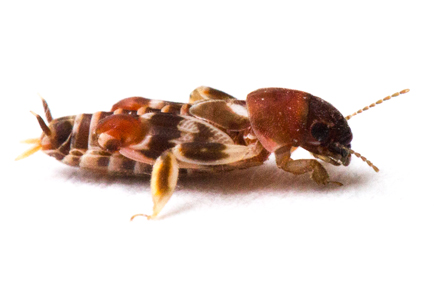Abstract
The results of an intensive survey of Florida (U.S.A.) Pygmy Mole Crickets (Orthoptera: Tridactylidae) are presented. Six members of the family have been previously recorded from the state. This work describes three additional species and documents additional locality records for the other taxa, bringing the Florida total to nine species. Two-thirds of these species are narrowly endemic to small ranges within the state and are restricted to xeric sandhill or scrub habitats with bare patches of sand. Distributional patterns as well as conservation implications for the endemic species are discussed.
References
- Deyrup, M. (1990) Arthropod footprints in the sands of time. Florida Entomologist, 73 (4), 529–538. https://doi.org/10.2307/3495269
- Deyrup, M. (1996) Two new grasshoppers from relict uplands of Florida (Orthoptera: Acrididae). Transactions of the American Entomological Society, 122 (4), 199–211.
- Deyrup, M. (2005) A new species of flightless Pygmy Mole Cricket from a Florida sand ridge (Orthoptera: Tridactylidae). Florida Entomologist, 88 (2), 141–145. https://doi.org/10.1653/0015-4040(2005)088[0141:ANSOFP]2.0.CO;2
- Deyrup, M. & Carrel, J. (2011) Final Report on Project T-15-D: Lake Wales Ridge Scrub Arthropods: U.S. Fish and Wildlife Service State Wildlife Grant. Archbold Biological Station, Venus, Florida. [unknown pagination]
- Deyrup, M. & Eisner, T. (1996) Description and natural history of a new Pygmy Mole Cricket from relict xeric uplands of Florida (Orthoptera: Tridactylidae). Memoirs of the Entomological Society of Washington, 17, 59–67.
- Günther, K.K. (1972) Die Tridactyloidea von Uruguay (Orthopteroidea, Saltatoria). Deutsche Entomologische Zeitschrift, 19 (1–3), 211–236. https://doi.org/10.1002/mmnd.4810190115
- Günther, K.K. (1975) Das Genus Neotridactylus Günther, 1972 (Tridactylidae, Saltatoria, Insecta). Mitteilungen aus dem Museum für Naturkunde in Berlin. Zoologisches Museum und Institut für Spezielle Zoologie, Berlin, 51 (2), 305–365. https://doi.org/10.1002/mmnz.19750510208
- Günther, K.K. (1977) Revision der Gattung Ellipes Scudder, 1902 (Saltatoria, Tridactylidae). Deutsche Entomologische Zeitschrift, 24 (1–3), 47–122. https://doi.org/10.1002/mmnd.4800240104
- Hawkes, C.V. & Flechtner, V.R. (2002) Biological soil crusts in a xeric Florida shrubland: composition, abundance, and spatial heterogeneity of crusts with different disturbance histories. Microbial Ecology, 43 (1), 1–12. https://doi.org/10.1007/s00248-001-1017-5
- Lamb, T., Justice, T.C., Brewer, M.S., Moler, P.E., Hopkins, H. & Bond, J.E. (2018) A biogeographical profile of the sand cockroach Arenivaga floridensis and its bearing on origin hypotheses for Florida scrub biota. Ecology and Evolution, 8 (11), 5254–5266. https://doi.org/10.1002/ece3.3885
- Myers, R.L. (1985) Fire and the dynamic relationship between Florida sandhill and sand pine scrub vegetation. Bulletin of the Torrey Botanical Club, 112 (3), 241–252. https://doi.org/10.2307/2996539
- Noss, R.F., Platt, W.J., Sorrie, B.A., Weakley, A.S., Means, D.B., Costanza, J. & Peet, R.K. (2015) How global biodiversity hotspots may go unrecognized: lessons from the North American Coastal Plain. Diversity and Distributions, 21 (2), 236–244. https://doi.org/10.1111/ddi.12278
- Skelley, P.E. (2006) A revision of the genus Geopsammodius Gordon and Pittino, 1992 (Scarabaeidae: Aphodiinae: Psammodiini). Insecta Mundi, 20 (1–2), 101–112.
- Woller, D.A. (2025) Three new grasshopper species in the Florida Melanoplus Puer Group (Orthoptera: Acrididae: Melanoplinae). Zootaxa, 5631 (2), 269–307. https://doi.org/10.11646/zootaxa.5631.2.3
- Otte, D. (2014) Aptenopedes and two new related genera in Florida, with a description of fourteen new species (Acrididae: Melanoplinae). Transactions of the American Entomological Society, 140 (1), 245–292. https://doi.org/10.3157/061.140.0115
- Woo, B. (2021) A new species of Pygmy Mole Cricket (Orthoptera: Tridactylidae) from the Lake Wales ridge of Florida and new records of Ellipes eisneri from the northern Brooksville ridge. Journal of Orthoptera Research, 30 (2), 131–143. https://doi.org/10.3897/jor.30.65603


